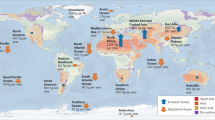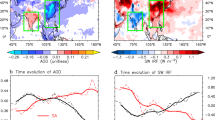Abstract
Changes in global temperature are generally more marked in high than in low latitudes, an effect referred to as polar amplification1,2,3. Model simulations of future climate suggest a marked response of high-latitude climate due to elevated greenhouse-gas concentrations and associated albedo feedbacks4. However, most climate models struggle to reproduce the amplitude of polar temperature change observed in palaeoclimatic archives3 and may carry this bias into future predictions. With the example of mineral dust we show that some atmospheric aerosols experience an amplified high-latitude response to global changes as well, a phenomenon generally not captured by the models. Using a synthesis of observational and model data we reconstruct atmospheric dust concentrations for Holocene and Last Glacial Maximum (LGM) conditions. Radiative forcing calculations based on our new dust concentration reconstructions suggest that the impact of aerosols in polar areas is underestimated in model simulations for dustier-than-modern conditions. In the future, some simulations predict an increase in aridity in dust source areas5. Other aerosols such as black carbon and sulphates are likely to increase as well6,7. We therefore suggest that the inclusion of the amplified high-latitude response of aerosols in atmospheric models would improve the assessment of LGM and future polar amplification.
This is a preview of subscription content, access via your institution
Access options
Subscribe to this journal
Receive 12 print issues and online access
$209.00 per year
only $17.42 per issue
Buy this article
- Purchase on Springer Link
- Instant access to full article PDF
Prices may be subject to local taxes which are calculated during checkout



Similar content being viewed by others
References
Serreze, M. C. & Francis, J. A. The Arctic amplification debate. Climatic Change 76, 241–264 (2006).
Rigor, I. G., Colony, R. L. & Martin, S. Variations in surface air temperature observations in the Arctic, 1979–97. J. Clim. 13, 896–914 (2000).
Masson-Delmotte, V. et al. Past and future polar amplification of climate change: Climate model intercomparisons and ice-core constraints. Clim. Dynam. 26, 513–529 (2005).
Randall, D. et al. in IPCC Climate Change 2007: The Physical Science Basis (eds Solomon, S. et al.) Ch. 8 (Cambridge Univ. Press, 2007).
Dai, A. Drought under global warming: A review. WIRes Clim. Change 2, 45–65 (2011).
Leibensperger, E. M. et al. Climatic effects of 1950–2050 changes in US anthropogenic aerosols–Part 1: Aerosol trends and radiative forcing. Atmos. Chem. Phys. 12, 3333–3348 (2012).
Song, W. W., He, K. B. & Lei, Y. Black carbon emissions from on-road vehicles in China, 1990–2030. Atmos. Environ. 51, 320–328 (2012).
Screen, J. A. & Simmonds, I. The central role of diminishing sea ice in recent Arctic temperature amplification. Nature 464, 1334–1337 (2010).
Rind, D. & Chandler, M. Increased ocean heat transports and warmer climate. J. Geophys. Res. 96, 7437–7461 (1991).
Graversen, R. G., Mauritsen, T., Tjernström, M., Källén, E. & Svensson, G. Vertical structure of recent Arctic warming. Nature 451, 53–6 (2008).
Shakun, J. D. et al. Global warming preceded by increasing carbon dioxide concentrations during the last deglaciation. Nature 484, 49–54 (2012).
Alley, R. B. The Younger Dryas cold interval as viewed from central Greenland. Quat. Sci. Rev. 19, 213–226 (2000).
Jouzel, J. et al. Orbital and millennial Antarctic climate variability over the past 800,000 years. Science 317, 793–796 (2007).
Claquin, T. et al. Radiative forcing of climate by ice-age atmospheric dust. Clim. Dynam. 20, 193–202 (2003).
Jansen, E. et al. in IPCC Climate Change 2007: The Physical Science Basis (eds Solomon, S. et al.) Ch. 6 (Cambridge Univ. Press, 2007).
Lambert, F. et al. Dust-climate couplings over the past 800,000 years from the EPICA Dome C ice core. Nature 452, 616–619 (2008).
Miller, R. L. & Tegen, I. Climate response to soil dust aerosols. J. Clim. 11, 3247–3267 (1998).
Sassen, K., Demott, P. J., Prospero, J. M. & Poellot, M. R. Saharan dust storms and indirect aerosol effects on clouds: CRYSTAL-FACE results. Geophys. Res. Lett. 30, 1–4 (2003).
Ichoku, C., Kaufman, Y., Remer, L. & Levy, R. Global aerosol remote sensing from MODIS. Adv. Space Res. 34, 820–827 (2004).
Mahowald, N. M. et al. Change in atmospheric mineral aerosols in response to climate: Last glacial period, preindustrial, modern, and doubled carbon dioxide climates. J. Geophys. Res. 111, D10202 (2006).
Takemura, T. et al. A simulation of the global distribution and radiative forcing of soil dust aerosols at the Last Glacial Maximum. Atmos. Chem. Phys. 9, 3061–3073 (2009).
Kohfeld, K. E. & Harrison, S. P. DIRTMAP: The geological record of dust. Earth Sci. Rev. 54, 81–114 (2001).
Mlawer, E. J., Taubman, S. J., Brown, P. D., Iacono, M. J. & Clough, S. A. Radiative transfer for inhomogeneous atmospheres: RRTM, a validated correlated-k model for the longwave. J. Geophys. Res. 102, 16663–16682 (1997).
Neff, J. C. et al. Increasing eolian dust deposition in the western United States linked to human activity. Nature Geosci. 1, 189–195 (2008).
Mahowald, N. M. et al. Observed 20th century desert dust variability: Impact on climate and biogeochemistry. Atmos. Chem. Phys. 10, 10875–10893 (2010).
Woodward, S. A simulation of the effect of climate change–induced desertification on mineral dust aerosol. Geophys. Res. Lett. 32, 2–5 (2005).
Mahowald, N. M. Anthropocene changes in desert area: Sensitivity to climate model predictions. Geophys. Res. Lett. 34, L18817 (2007).
Ruth, U., Wagenbach, D., Steffensen, J. P. & Bigler, M. Continuous record of microparticle concentration and size distribution in the central Greenland NGRIP ice core during the last glacial period. J. Geophys. Res. 108, 1–12 (2003).
Winckler, G., Anderson, R. F., Fleisher, M. Q., McGee, D. & Mahowald, N. Covariant glacial–interglacial dust fluxes in the equatorial Pacific and Antarctica. Science 320, 93–96 (2008).
Mahowald, N. M. et al. Climate response and radiative forcing from mineral aerosols during the last glacial maximum, pre-industrial, current and doubled-carbon dioxide climates. Geophys. Res. Lett. 33, 2–5 (2006).
Acknowledgements
This work was supported by the National Research Foundation of Korea (Grant NRF-2009-C1AAA001-2009-0093042) funded by the Korean government (MEST), and KIOST (PE98801). R.J.P. was supported by the Basic Science Research Program through the NRF of Korea funded by the Ministry of Education, Science and Technology (2009-0093459). T.T. was supported by the Funding Program for Next Generation World-Leading Researchers by the Cabinet Office, Government of Japan (GR079).
Author information
Authors and Affiliations
Contributions
F.L. wrote the paper, performed the experiments and analysed the data. F.L. and J-S.K. designed the research. All authors discussed the results and commented on the manuscript.
Corresponding author
Ethics declarations
Competing interests
The authors declare no competing financial interests.
Supplementary information
Supplementary Information
Supplementary Information (PDF 1947 kb)
Rights and permissions
About this article
Cite this article
Lambert, F., Kug, JS., Park, R. et al. The role of mineral-dust aerosols in polar temperature amplification. Nature Clim Change 3, 487–491 (2013). https://doi.org/10.1038/nclimate1785
Received:
Accepted:
Published:
Issue Date:
DOI: https://doi.org/10.1038/nclimate1785
This article is cited by
-
Chemical characterization and speciation of the soluble fraction of Arctic PM10
Analytical and Bioanalytical Chemistry (2024)
-
Polar amplification comparison among Earth’s three poles under different socioeconomic scenarios from CMIP6 surface air temperature
Scientific Reports (2022)
-
The Holocene temperature conundrum answered by mollusk records from East Asia
Nature Communications (2022)
-
An assessment of the spatial extent of polar dust using satellite thermal data
Scientific Reports (2021)
-
Interdecadal changes in synoptic transient eddy activity over the Northeast Pacific and their role in tropospheric Arctic amplification
Climate Dynamics (2021)



